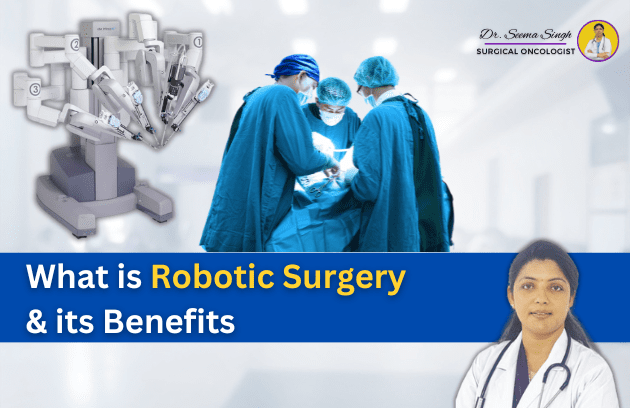- December 5, 2023
- Dr Seema Singh
- Comment: 0
- Uncategorized
What is robotic surgery?
Robot-assisted surgery involves special technology that makes your surgeon’s hands more capable. This technology lets surgeons do operations in tricky spots using small cuts. The special tools also allow very careful movements and make things look bigger and clearer.
The technology includes:
- Surgical arms with small tools that have wrists at the end.
- A special camera that shows a bigger and clearer 3D view of the surgery area.
- A surgical console where the surgeon guides the tools and camera in every step.
What Happens During Robotic Surgery?
During robotic surgery, your surgeon begins by creating one or more small incisions. Through these incisions, thin tubes called ports are inserted, to which the robot is attached. Instruments are then introduced through these ports.
One of the ports accommodates a long, thin camera known as an endoscope, providing high-definition 3D images throughout the surgical procedure. The remaining ports allow the placement of surgical instruments, enabling the surgeon to perform the operation.
While seated at a console a few feet away from you, your surgeon takes control of the robotic arm. An assistant remains by your side to assist the surgeon by changing instruments as necessary.
What are the advantages of robotic surgery?
One of the primary benefits is its capability to conduct surgery through smaller incisions.
Additional advantages of robotic surgery include:
Greater Precision: The movements of the robotic arm are more precise than those of a human hand, offering a broader range of motion. This enables the rotation of instruments in tight spaces, which may be challenging or impossible for a human hand.
Enhanced Visualization: A sophisticated camera provides magnified, high-definition views of the surgical area. The camera also possesses 3D capabilities, surpassing the visual capabilities of the naked eye.
Intra-Body Surgery: The use of small instruments allows surgeons to perform specific steps of the operation within the body. Traditionally, a much larger incision would have been required to carry out these procedures outside of the body.
Robot-assisted surgery offers several benefits, including:
Reduced Pain During Recovery: Patients often experience less pain during the recovery period compared to traditional surgery.
Lower Risk of Infection: The use of robotic assistance can contribute to a decreased risk of post-operative infections.
Reduced Blood Loss: Robot-assisted procedures are associated with less blood loss, enhancing patient safety.
Shorter Hospital Stays: Patients undergoing robotic surgery typically have shorter hospital stays compared to those undergoing traditional procedures.
Smaller Scars: The smaller incisions used in robot-assisted surgery result in smaller scars, providing both cosmetic and potential physical benefits for patients.
What are the drawbacks of robotic surgery?
Challenges associated with robot-assisted surgery include:
Limited Availability: Only accessible in medical centers with the financial capacity to afford the technology and employ specially trained surgeons.
Potential for Conversion to Open Procedure: Surgeons may need to switch to an open procedure with larger incisions in the presence of complications. These complications can include challenges such as scar tissue from previous surgeries, hindering the completion of the procedure with robotic technology.
Risk of Nerve Damage and Compression: There is a potential risk of nerve damage and compression associated with robot-assisted surgery.
Rare Robotic Malfunction: Although extremely rare, there exists a possibility of robotic malfunction during surgery.
Robotics Surgical Oncologist in Delhi NCR, Get Consultation
If you are searching for robotics surgical oncologist in delhi, then you can consult Dr. Seema Singh who is the Best Robotic Gynae Onco Surgeon, she has an experience of 15 years in the field of surgical oncology.


